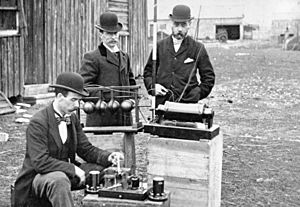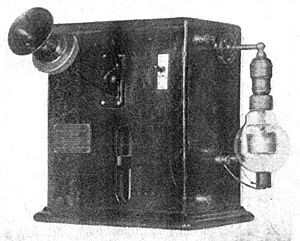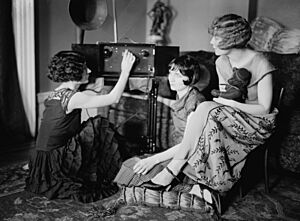History of radio facts for kids
The history of radio is all about how we learned to send messages and sounds through the air using invisible radio waves. Many smart people helped invent and improve radio over time. At first, it was called "wireless telegraphy" because it was like sending telegraph messages without wires. Later, radio became popular for broadcasting music, news, and stories to many people at once.
Contents
- Discovering Radio Waves
- Exploring How Radio Waves Work
- Marconi and Wireless Telegraphy
- Sending Sounds and Voices
- Radio Companies
- How Radio Technology Grew
- Radio for Text and Pictures
- Radio Navigation
- FM Radio
- Television
- Mobile Phones
- Radio and Copyright
- Rules for Radio Stations in the U.S.
- Early Public Radio Stations in the U.S.
- See also
- Media and documentaries
Discovering Radio Waves
In 1864, a scientist named James Clerk Maxwell came up with ideas about electromagnetism. He showed that light, radio waves, and X-rays are all types of electromagnetic waves. These waves travel through empty space.
Later, between 1886 and 1888, Heinrich Rudolf Hertz did experiments. He was able to send electromagnetic waves, which we now call radio waves, through the air. This proved Maxwell's ideas were correct.
Exploring How Radio Waves Work
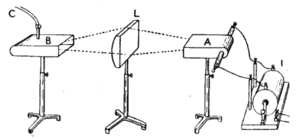
After radio waves were discovered, many scientists tried sending and finding these "Hertzian waves." It took almost 20 years for everyone to start calling them "radio" waves. Scientists like John Perry and William Crookes thought these waves could be used for navigation or communication.
In 1894, a British scientist named Oliver Lodge gave a famous talk about Hertzian waves. He showed how to send and detect them. He used a special tool called a "coherer" to find the waves. Lodge also showed that radio waves act like light. They can bend, spread out, and even create patterns, just like light waves.
Scientists then started experimenting with very short radio waves, similar to light. Oliver Lodge and Augusto Righi worked with microwaves. A Russian scientist, Pyotr Lebedev, did experiments with even shorter waves. An Indian scientist, Jagadish Chandra Bose, worked with tiny millimeter-sized waves. He even invented special tools like waveguides and horn antennas. In 1895, Bose publicly showed how his waves could set off detectors and ring a bell from a distance.
Some people thought these "invisible light" waves could help ships in fog or storms. They thought radio could change how lighthouses work around the world.
In 1895, a Russian scientist named Alexander Stepanovich Popov built a lightning detector. It used a radio receiver based on Lodge's ideas. He showed it off in May 1895.
Marconi and Wireless Telegraphy
In 1894, a young Italian inventor named Guglielmo Marconi started working on sending messages wirelessly over long distances. He used radio waves. Marconi studied what other inventors were doing. He then worked hard to make his own devices better. He created portable transmitters and receivers that could work over long distances. He turned a lab experiment into a useful way to communicate.
By August 1895, Marconi was testing his system. At first, he could only send signals about half a mile. But then, he made a big improvement. He made his antenna taller and connected his transmitter and receiver to the ground. With these changes, he could send signals up to two miles and even over hills! This was the first successful radio system that could be used for business. Marconi received a patent for his invention in 1896.
Sending Messages Across Oceans
In 1897, Marconi set up a radio station in England. In 1898, he opened his first "wireless" factory. About 60 people worked there.
On December 12, 1901, Marconi sent a message across the Atlantic Ocean. He used a tall antenna held up by a kite. The signal came from a powerful station in England. It was received in St. John's, Newfoundland, Canada.
Marconi then built powerful stations on both sides of the Atlantic. This allowed him to talk to ships at sea. In 1904, he started a service to send nightly news summaries to ships. Ships could then print these into their own newspapers. A regular radio-telegraph service across the Atlantic began in 1907.
Marconi's radio equipment is also famous for helping to save 700 people from the sinking Titanic ship in 1912.
Sending Sounds and Voices
In the late 1890s, a Canadian-American inventor named Reginald Fessenden had an idea. He thought he could make a much better radio system. He worked on a special machine that made a steady, continuous radio wave. This was different from the short bursts of waves that other systems used.
Fessenden worked for the U.S. Weather Bureau. He experimented with sending voices over the radio. By the fall of 1900, he successfully sent speech about one mile. This was likely the first time someone sent audio using radio signals. The sound was not perfect, but it was a start.
According to some stories, on Christmas Eve in 1906, Fessenden made the first radio audio broadcast. He played O Holy Night on his violin and read from the Bible. Ships at sea heard his broadcast.
Around the same time, an American inventor named Lee de Forest also experimented with sending steady radio waves. In February 1907, he sent electronic music from his lab in New York City. Later, he sent a singer's voice. In July 1907, he made ship-to-shore calls using radio. He sent race reports for a yachting event on Lake Erie.
Radio Broadcasting
The first regular radio entertainment broadcast happened in the Netherlands. A company called Nederlandsche Radio-Industrie started broadcasting from its workshop in The Hague on November 6, 1919. They broadcast four nights a week.
Regular entertainment broadcasts also began in Argentina. On August 27, 1920, Sociedad Radio Argentina broadcast a live opera from a theater in Buenos Aires. Only about 20 homes in the city had radios to listen.
In the U.S., the Detroit News started daily news and entertainment broadcasts on August 31, 1920. Union College in New York also began broadcasting in October 1920. They had concerts that could be heard far away.
In 1922, regular audio broadcasts for fun started in the UK. These came from the Marconi Research Centre.
Wavelength and Frequency
In the early days of radio, stations were known by their "wavelength," which was the length of the radio wave. This is why we still hear terms like long wave, medium wave, and short wave radio. For example, the 40-meter band was used by amateur radio fans.
Wavelength and frequency are connected. A higher frequency means a shorter wave, and vice versa. As radio technology got better, it was easier to control the exact frequency. So, people started using frequency (like kilocycles or megacycles) to identify signals. Around 1965, the term "hertz" (cycles per second) became the standard.
Radio Companies
British Marconi
The British Marconi company was started in 1897 by Guglielmo Marconi. It used his patents to create communication between coast radio stations and ships. In 1898, they opened their first radio station in Chelmsford. This company and its related companies, Canadian Marconi and American Marconi, controlled ship-to-shore communication. They owned all their equipment and would not talk to ships that did not use Marconi's system.
Telefunken
The company Telefunken was founded in Germany on May 27, 1903. It was a joint project between two big companies, Siemens & Halske and AEG. In 1911, the German leader, Kaiser Wilhelm II, sent Telefunken engineers to New York. They built three very tall radio towers there. Nikola Tesla helped with the building. A similar station was built in Germany. These two stations created the only wireless communication between North America and Europe at the time.
How Radio Technology Grew
AM Radio
The invention of amplitude modulation (AM) radio was a big step. AM radio allows many stations to send signals at the same time without interfering too much. This is different from older spark-gap radios, which took up a lot of space on the airwaves. Reginald Fessenden, Valdemar Poulsen, and Lee de Forest are credited with inventing AM radio.
Crystal Radios
Before vacuum tubes, the most common type of radio receiver was the crystal radio. These radios were simple and did not need electricity or batteries to work. They got all their power from the antenna. So, the sound was not very loud.
Crystal radios are still used today as a fun hobby. Groups like the Boy Scouts of America use them to teach young people about electronics and radio.
Vacuum Tubes
In the mid-1920s, amplifying vacuum tubes changed radio forever. They made radio receivers and transmitters much better. John Ambrose Fleming created a basic vacuum tube called a diode. Lee de Forest added a special part called a "grid," creating the triode. This allowed the radio signal to be made stronger.
Early radios often needed batteries. But in 1926, the "battery eliminator" came out. This allowed radios to get power from the wall outlet. By 1927, radios that did not need any batteries at all became available.
A problem with early radios was that stations would fade in and out, and the volume would change. The invention of the superheterodyne receiver solved this. The first radios with this technology went on sale in 1924.
Loudspeakers
In the very early days, you had to use headphones to listen to the radio. Later, loudspeakers became available. They looked like horns, similar to old phonographs. But the sound quality was not great. In 1926, the first radios with better loudspeakers went on sale. These greatly improved the sound. Soon, radios came with built-in loudspeakers.
Other inventions helped improve sound. In 1928, automatic volume control (AVC) was introduced. In 1930, a tone control knob was added. This let listeners adjust the sound quality.
The magnetic cartridge, invented in the mid-1920s, also made a big difference for broadcasting music. Before this, a microphone had to be placed near a phonograph's horn to broadcast music. The new invention allowed music signals to be sent directly to the radio transmitter.
Transistor Technology
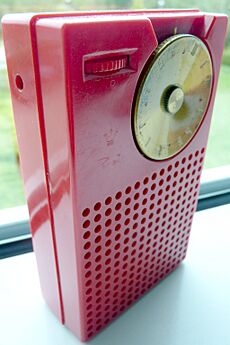
After transistor technology was developed, bipolar junction transistors led to the creation of the transistor radio. In 1954, the Regency company released a small pocket transistor radio. In 1955, the new Sony company introduced its first transistor radio. It was small enough to fit in a pocket and ran on a small battery. It was also very strong because it did not have fragile vacuum tubes.
By the mid-1960s, the Radio Corporation of America (RCA) was using new types of transistors called MOSFETs in their products. These were used in FM radios, televisions, and amplifiers.
Integrated Circuits
The first integrated circuit (IC) radio, made by General Electric, came out in 1966. ICs made radios even smaller and more powerful.
Car Radio
The first car radio was introduced in 1922. But it was so big it took up too much space. The first commercial car radio that could easily fit in most cars went on sale in 1930.
Radio for Text and Pictures
Even with voice radio, sending text messages was still important. In the 1930s, teletypewriters automated sending text over wires. This service was called telex. For many years, telex was the cheapest way to send long-distance messages. It was useful for businesses and governments because it created written documents.
Telex systems were adapted for short-wave radio. This was called telex-on-radio (TOR). For a long time, TOR was the only reliable way to reach some countries.
Pictures and maps could also be sent by radio using radiofax. This was invented in 1924 by Richard H. Ranger of Radio Corporation of America (RCA). This method was popular in the mid-1900s.
In the early 1900s, airplanes started using commercial AM radio stations to help them navigate. AM stations are still marked on aviation maps in the U.S. Radio navigation was very important during wars, especially World War II.
As radio technology improved, navigation became easier and more accurate. However, radio navigation systems often needed complex equipment. Users had to learn how to use tools like the radio compass receiver or radar.
In the 1960s, VOR systems became common. In the 1970s, LORAN became the main radio navigation system. Soon, the U.S. Navy started experimenting with satellite navigation. In 1987, the Global Positioning System (GPS) satellites were launched. Other similar systems like Glonass and Galileo followed.
FM Radio
In 1933, FM radio was patented by Edwin H. Armstrong. FM uses a different way of sending radio waves called frequency modulation. This helps to reduce static and interference from electrical equipment and the atmosphere. In 1937, the first experimental FM radio station was given permission to build.
FM in Europe
After World War II, FM radio broadcasting started in Germany. At a meeting in 1948, new plans were made for radio wavelengths in Europe. Germany was not invited to this meeting. So, they were only given a few medium-wave frequencies, which were not very good. Because of this, Germany started broadcasting on UKW (ultra short wave, now called VHF).
People soon realized that FM radio was much better for VHF radio than AM. Because of this history, FM radio is still called "UKW Radio" in Germany. Other European countries followed later. They saw that FM had better sound quality and allowed for more local stations. This was because VHF broadcasts did not travel as far.
Television
In the 1930s, regular analog television broadcasting began in some parts of Europe and North America. By the end of that decade, there were about 25,000 electronic televisions in the world. Most of them were in the UK. In the U.S., Armstrong's FM system was chosen to send and receive television sound.
Color Television
- 1953: NTSC compatible color television was introduced in the U.S.
- 1962: Telstar 1, the first communications satellite, sent the first live television signal across the Atlantic Ocean.
- Mid-1960s: MOSFETs (a type of transistor) were first used for television by the Radio Corporation of America (RCA).
By 1963, color television was being broadcast for business. The first radio communication satellite, Telstar, was launched.
Mobile Phones
In 1947, AT&T started the Mobile Telephone Service. By 1948, it was available in many towns and along highways. This service was rare, with only about 5,000 customers. Only three people in any city could make a mobile call at one time. It was also very expensive.
The development of new transistor technology and cellular networks led to more affordable mobile communications. The Advanced Mobile Phone System (AMPS) was introduced in 1978. It allowed for many more mobile phone calls. It was the main mobile phone system in North America through the 1980s and into the 2000s.
Radio and Copyright
When radio started in the early 1920s, many people thought it would ruin the phonograph record industry. Radio offered free music, which people usually paid for by buying records. Some record companies did not want their music played on the radio. They even made their famous singers promise not to perform on radio shows.
The music recording industry did see a big drop in profits after radio became popular. For a while, it seemed like radio was a real threat. Radio ownership grew a lot, but record sales fell. This was also partly because of the Great Depression.
Copyright owners were worried they would not make money from the free music on radio. But copyright law said that they had control over public performances "for profit." The question was whether radio stations were making a profit from the songs.
A key court case happened in 1922 against Bamberger's Department Store in Newark, New Jersey. The store was broadcasting music from its radio station. It was decided that Bamberger's was using the songs to make money for their business. This meant it was a public performance for profit, and the copyright owners should be paid.
After this ruling, the American Society of Composers, Authors and Publishers (ASCAP) started collecting fees from radio stations in 1923. At first, it was $250 for all music protected by ASCAP. But for bigger stations, the price quickly went up to $5,000. Today, radio and TV licensing is the biggest source of money for ASCAP and its composers.
Rules for Radio Stations in the U.S.
Wireless Ship Act of 1910
Radio technology was first used for ships to talk to each other at sea. To keep people safe, the Wireless Ship Act of 1910 was the first U.S. law about radio systems on ships. It said that ships traveling far from shore or carrying many people needed a radio system with a trained operator. However, this law had problems. Radio companies sometimes delayed messages from ships using a competitor's system. This problem contributed to the sad sinking of the Titanic in 1912.
Radio Act of 1912
In 1912, when the Titanic was sinking, many radio messages caused confusion. This made rescue efforts harder. Because of this, the U.S. government passed the Radio Act of 1912. This law helped separate normal radio messages from emergency calls. It also explained the government's role during emergencies.
The Radio Act of 1927
The Radio Act of 1927 gave the Federal Radio Commission the power to give out and take away radio licenses. It also let them decide which frequencies and power levels stations could use. In 1928, they started requiring licenses for existing stations. Some stations could not get a license and had to stop broadcasting. The Act also said that radio broadcasts should be free, and the government could not control the content.
The Communications Act of 1934
The Communications Act of 1934 created the Federal Communications Commission (FCC). The FCC's job is to control industries like telephone, telegraph, and radio. This Act also allows the President to use communication facilities during wartime if needed.
The Telecommunications Act of 1996
The Telecommunications Act of 1996 was a big update to the Communications Act of 1934. It aimed to make telecommunications more competitive. Some of the goals of this Act are still being worked on today.
Early Public Radio Stations in the U.S.
It is hard to say which was the very first public radio station in the U.S. because it depends on what you mean by "regular" programming.
- Many people say KDKA in Pittsburgh, Pennsylvania, was the first. It got its license in October 1920 and started broadcasting on November 2, 1920, with presidential election results. But it did not broadcast daily until 1921.
- On February 17, 1919, station 9XM at the University of Wisconsin in Madison broadcast human speech to the public. This station, now WHA, started regular voice and music broadcasts in January 1921.
- On August 20, 1920, 8MK began broadcasting daily. Lee de Forest claimed it was the first commercial station. It later became WWJ in Detroit. It has broadcast regularly ever since.
- The first station to get a commercial license was WBZ in Springfield, Massachusetts. It received its license on September 15, 1921.
See also
 In Spanish: Historia de la radio para niños
In Spanish: Historia de la radio para niños
- History of electrical engineering
- History of electromagnetic theory
- History of amateur radio
- History of broadcasting
- History of podcasting
- History of radar
- History of telecommunication
- History of television
- Digital audio broadcasting (DAB)
- Internet radio
- Wireless
Media and documentaries
- Empire of the Air: The Men Who Made Radio (1992) by Ken Burns, a PBS documentary about the history of radio.




